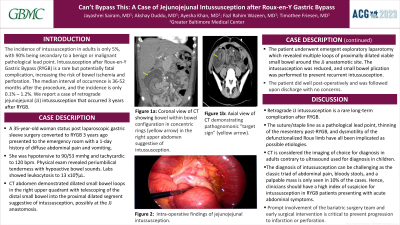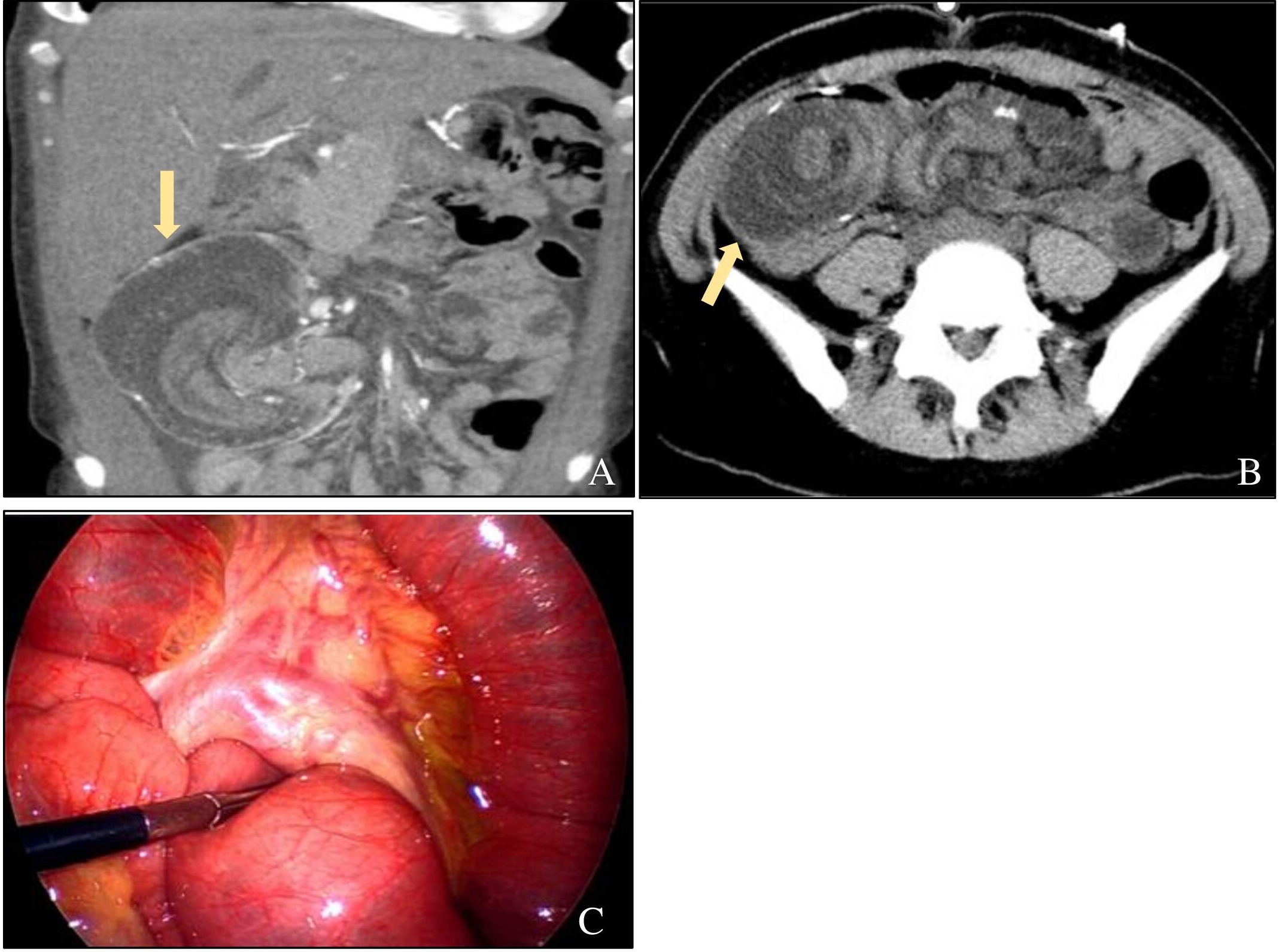Monday Poster Session
Category: Small Intestine
P2645 - Can’t Bypass This: A Case of Jejunojejunal Intussusception After Roux-en-Y Gastric Bypass
Monday, October 23, 2023
10:30 AM - 4:15 PM PT
Location: Exhibit Hall

Has Audio
- JS
Jayashrei Sairam, MD
Greater Baltimore Medical Center
Towson, MD
Presenting Author(s)
Jayashrei Sairam, MD, Akshay Duddu, MD, Ayesha Khan, MD, Fazl Rahim Wazeen, MD, Timothee Friesen, MD
Greater Baltimore Medical Center, Towson, MD
Introduction: The incidence of intussusception in adults is only 5%, with 90% being secondary to a benign or malignant pathological lead point. Roux-en-Y gastric bypass (RYGB) is the most common bariatric procedure performed for morbid obesity. Intussusception is a rare but potentially fatal complication after RYGB, increasing the risk of bowel ischemia and perforation. The incidence is only 0.1%-1.2% with a median interval of 36-52 months after the procedure. We report a case of retrograde jejunojejunal (JJ) intussusception that occurred 3 years after RYGB.
Case Description/Methods: A 35-year-old woman with a history of laparoscopic gastric sleeve surgery converted to RYGB 3 years ago presented to the emergency department with a 1-day history of diffuse abdominal pain, nausea, and vomiting. On presentation, she was hypotensive and tachycardic with noted periumbilical tenderness and hypoactive bowel sounds. Labs showed leucocytosis to 13 x10³/µL. A CT abdomen revealed dilated small bowel loops in the right upper quadrant with telescoping of the distal small bowel into the proximal dilated segment suggestive of intussusception, possibly at the JJ anastomosis. The patient underwent emergent exploratory laparotomy which revealed multiple loops of proximally dilated small bowel around the JJ anastomotic site which appeared viable. The intussusception was reduced, and small bowel plication to prevent recurrent intussusception was performed. Surgical findings also revealed an internal hernia involving the entire small bowel at the Petersen's defect (between the Roux limb and the transverse colon) which was reduced. The patient did well post-operatively and was followed upon discharge with no concerns.
Discussion: Retrograde JJ intussusception is a rare long-term complication after RYGB. The suture/staple line has been thought to be a possible pathological lead point though thinning of the associated mesentery, and dysmotility of the defunctionalized Roux limb have been hypothesized as possible etiologies. CT is considered the imaging of choice contrary to ultrasound for diagnosis in children. Clinicians should have a high index of suspicion for intussusception in RYGB patients presenting with acute onset of abdominal symptoms as the classic triad of abdominal pain, bloody stools, and a palpable mass is only seen in 10% of the cases and the diagnosis can be challenging. Prompt involvement of the bariatric surgery team and early surgical intervention is critical to prevent progression to infarction or perforation.

Disclosures:
Jayashrei Sairam, MD, Akshay Duddu, MD, Ayesha Khan, MD, Fazl Rahim Wazeen, MD, Timothee Friesen, MD. P2645 - Can’t Bypass This: A Case of Jejunojejunal Intussusception After Roux-en-Y Gastric Bypass, ACG 2023 Annual Scientific Meeting Abstracts. Vancouver, BC, Canada: American College of Gastroenterology.
Greater Baltimore Medical Center, Towson, MD
Introduction: The incidence of intussusception in adults is only 5%, with 90% being secondary to a benign or malignant pathological lead point. Roux-en-Y gastric bypass (RYGB) is the most common bariatric procedure performed for morbid obesity. Intussusception is a rare but potentially fatal complication after RYGB, increasing the risk of bowel ischemia and perforation. The incidence is only 0.1%-1.2% with a median interval of 36-52 months after the procedure. We report a case of retrograde jejunojejunal (JJ) intussusception that occurred 3 years after RYGB.
Case Description/Methods: A 35-year-old woman with a history of laparoscopic gastric sleeve surgery converted to RYGB 3 years ago presented to the emergency department with a 1-day history of diffuse abdominal pain, nausea, and vomiting. On presentation, she was hypotensive and tachycardic with noted periumbilical tenderness and hypoactive bowel sounds. Labs showed leucocytosis to 13 x10³/µL. A CT abdomen revealed dilated small bowel loops in the right upper quadrant with telescoping of the distal small bowel into the proximal dilated segment suggestive of intussusception, possibly at the JJ anastomosis. The patient underwent emergent exploratory laparotomy which revealed multiple loops of proximally dilated small bowel around the JJ anastomotic site which appeared viable. The intussusception was reduced, and small bowel plication to prevent recurrent intussusception was performed. Surgical findings also revealed an internal hernia involving the entire small bowel at the Petersen's defect (between the Roux limb and the transverse colon) which was reduced. The patient did well post-operatively and was followed upon discharge with no concerns.
Discussion: Retrograde JJ intussusception is a rare long-term complication after RYGB. The suture/staple line has been thought to be a possible pathological lead point though thinning of the associated mesentery, and dysmotility of the defunctionalized Roux limb have been hypothesized as possible etiologies. CT is considered the imaging of choice contrary to ultrasound for diagnosis in children. Clinicians should have a high index of suspicion for intussusception in RYGB patients presenting with acute onset of abdominal symptoms as the classic triad of abdominal pain, bloody stools, and a palpable mass is only seen in 10% of the cases and the diagnosis can be challenging. Prompt involvement of the bariatric surgery team and early surgical intervention is critical to prevent progression to infarction or perforation.

Figure: Image 'A' shows computed tomography (coronal view) revealing bowel within bowel configuration in concentric rings (yellow arrow) in the right upper abdomen suggestive of intussusception. Image 'B' shows a computed tomography (axial view) demonstrating pathognomonic "target sign" (yellow arrow). Image 'C' shows intra-operative findings of jejunojejunal intussusception.
Disclosures:
Jayashrei Sairam indicated no relevant financial relationships.
Akshay Duddu indicated no relevant financial relationships.
Ayesha Khan indicated no relevant financial relationships.
Fazl Rahim Wazeen indicated no relevant financial relationships.
Timothee Friesen indicated no relevant financial relationships.
Jayashrei Sairam, MD, Akshay Duddu, MD, Ayesha Khan, MD, Fazl Rahim Wazeen, MD, Timothee Friesen, MD. P2645 - Can’t Bypass This: A Case of Jejunojejunal Intussusception After Roux-en-Y Gastric Bypass, ACG 2023 Annual Scientific Meeting Abstracts. Vancouver, BC, Canada: American College of Gastroenterology.
